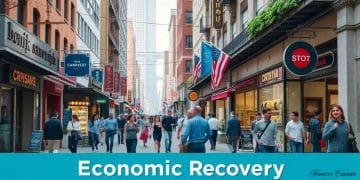Global economic recovery post-pandemic: what’s next?

The global economic recovery post-pandemic relies on key industries like technology and healthcare, addressing challenges such as supply chain disruptions while implementing effective strategies to adapt and support long-term growth.
The global economic recovery post-pandemic is a topic that touches every corner of our lives. Have you wondered how this shift influences your job or favorite brands? Let’s dive into these changes and what they mean for us all.
Understanding the current economic landscape
To understand the current economic landscape, it’s essential to look at various factors that influence it. The aftermath of the pandemic has reshaped many economic aspects, pushing businesses to adapt quickly. As we explore these layers, we can see how economies worldwide are trying to regain their footing.
Impact of Job Markets
The job market has experienced drastic changes. Many sectors had to lay off employees, leading to a significant increase in unemployment rates. However, as economies begin to recover, some industries are seeing a surge in hiring. Remote work and part-time positions have grown more common, showing how adaptable both employers and employees have become.
- Remote work opportunities expand.
- Shift towards gig economy roles.
- Increased demand for skilled workers in tech.
In addition, many workers have reconsidered their careers. The desire for better job satisfaction and work-life balance has led to higher turnover rates, known as the “Great Resignation.” This trend challenges businesses to rethink their employee strategies and work environments.
Changes in Consumer Behavior
Consumer behavior is also evolving. With the pandemic impacting spending habits, people are prioritizing essentials over luxury items. Moreover, e-commerce has grown tremendously as consumers prefer shopping online for its convenience and safety. Local businesses have ramped up their online presence to meet this demand.
- Shift towards sustainability in purchasing.
- Increased online shopping and delivery services.
- Preference for local products and services.
This shift in behavior not only affects individual businesses but also the entire economy. Companies must understand these changes to adjust their marketing strategies effectively.
Government Policy Changes
Finally, government policies play a critical role in shaping the economic landscape. Several countries have introduced stimulus packages to support struggling businesses and protect jobs. These measures aim to stabilize economies and foster recovery.
Yet, as these policies evolve, businesses must stay informed about potential regulations and adjustments. Awareness of these shifts can help them navigate this uncertain environment and seize new opportunities.
Key industries driving recovery

As the world moves towards a post-pandemic recovery, it is vital to recognize the key industries driving recovery. These sectors are essential as they not only generate jobs but also stimulate economic growth and innovation. Understanding these industries can provide insight into potential opportunities and challenges.
Technology Sector Growth
The technology sector is at the forefront of recovery. With an increased reliance on digital solutions, companies in software development, cybersecurity, and e-commerce have thrived. This industry’s rapid growth has created a surge in demand for skilled workers, making tech jobs a hot commodity.
- Expansion of cloud computing services.
- Increased investment in cybersecurity measures.
- Rapid growth of e-commerce platforms.
As businesses adopt new technologies, they are becoming more efficient and reaching broader audiences globally. This trend is likely to continue as innovation drives progress in various other fields.
Healthcare Innovations
The healthcare industry has also seen significant changes. The pandemic highlighted the need for rapid advancements in medical technologies and telehealth services. These innovations are paving the way for improved patient care and more efficient healthcare delivery systems.
- Expansion of telemedicine services.
- Increased focus on mental health support.
- Development of advanced healthcare technologies.
As we navigate through these changes, the focus on health and wellness becomes more pronounced, ensuring that the healthcare industry remains strong during recovery.
Green Energy Initiatives
Another important industry contributing to recovery is renewable energy. Governments around the world are investing in green energy initiatives to create sustainable jobs and reduce carbon footprints. This shift not only addresses environmental concerns but also stimulates economic growth.
As renewable technologies mature, jobs in solar and wind energy are increasing. This push for greener alternatives highlights a commitment to a more sustainable future while ensuring economic stability.
In summary, recognizing the key industries driving recovery offers a clearer understanding of the evolving job market and economic opportunities. By focusing on these sectors, businesses can adapt and grow alongside emerging trends.
Challenges faced by global economies
Global economies are currently navigating a complex landscape of challenges as they strive for recovery post-pandemic. These obstacles impact not only businesses but also communities and governments worldwide.
Supply Chain Disruptions
One major challenge is the disruption in supply chains. The pandemic caused delays in production and logistics, leading to shortages of key goods. In many cases, this has resulted in increased prices, affecting consumers and businesses alike.
- Shipping delays and rising costs.
- Shortages of raw materials.
- Increased consumer prices.
The ripple effect of these disruptions means that businesses may struggle to meet consumer demand, while consumers face higher costs and limited choices. Companies are now looking for ways to strengthen their supply chains to avoid similar issues in the future.
Inflation Concerns
Another pressing issue is inflation. Many countries are experiencing rising prices across various sectors. This inflation can erode purchasing power, making it harder for individuals to afford everyday essentials.
As inflation continues to rise, central banks may respond by increasing interest rates, which can further affect economic growth. This delicate balance between controlling inflation and supporting growth is a challenge for policymakers.
Labor Market Challenges
Labor market issues also pose significant challenges. Many industries are facing labor shortages, making it difficult to fill key positions. This shortage can delay projects and limit growth potential.
- Struggles to attract skilled workers.
- Increased wages to compete for talent.
- Changing employee expectations for remote work.
As businesses adapt, they must consider the evolving expectations of the workforce. The shift towards flexible work arrangements has become a critical factor in attracting and retaining talent.
Geopolitical Tensions
Lastly, geopolitical tensions can also impact global economic recovery. Political instability, trade disputes, and conflicts can hinder international trade and investment, creating uncertainty. Economies that rely heavily on exports are particularly vulnerable to these external factors.
In summary, while some industries are driving recovery, addressing the challenges faced by global economies is essential. Understanding these hurdles can help stakeholders devise effective strategies to foster resilience during this turbulent period.
Strategies for businesses to adapt

In a rapidly changing economic landscape, it is vital for businesses to adopt effective strategies for adaptation. These strategies not only ensure survival but also open up new avenues for growth in the midst of challenges.
Embracing Digital Transformation
One major strategy is embracing digital transformation. The pandemic accelerated the shift toward digital platforms, and businesses must evolve accordingly. Transitioning to online sales, utilizing digital marketing, and adopting new technologies can help companies connect better with their customers.
- Implementing e-commerce solutions for seamless online shopping.
- Using data analytics to understand customer behavior.
- Enhancing online customer service through chatbots and virtual assistance.
By enhancing their digital presence, businesses can reach a larger audience and improve customer engagement, which is essential for fostering loyalty.
Agility and Flexibility
Another important strategy is fostering agility and flexibility within the organization. Businesses should be prepared to pivot quickly in response to market changes. This may involve re-evaluating product lines, streamlining operations, or even changing business models entirely.
Flexibility in the workforce is key. Companies that offer remote working options or flexible schedules are more likely to retain talent. As the workplace evolves, being adaptable can lead to a more motivated and productive team.
Focus on Sustainability
Sustainability is becoming increasingly important in consumer decision-making. Businesses that prioritize sustainable practices can attract environmentally conscious customers. This can include sourcing materials responsibly, reducing waste, and implementing energy-efficient processes.
- Utilizing biodegradable or recyclable materials in products.
- Reducing carbon footprints through efficient operations.
- Engaging in corporate social responsibility initiatives.
By integrating sustainability into their core values, businesses can not only enhance their brand image but also contribute positively to the environment.
Networking and Collaboration
Lastly, building strong networks and collaborating with other businesses can create valuable opportunities. Partnerships can lead to shared resources, expanded markets, and new ideas. Engaging with local communities and industry groups fosters a support system that can help businesses thrive.
In summary, implementing effective strategies for businesses to adapt is crucial for navigating the post-pandemic landscape. By focusing on digital transformation, flexibility, sustainability, and collaboration, businesses can not only endure but thrive in the evolving economy.
The role of government policies in recovery
Government policies play a crucial role in shaping the economic landscape during recovery. The decisions made by policymakers can significantly impact businesses, employment, and overall economic health. Understanding this role helps to clarify how recovery can be supported through legislation and regulation.
Stimulus Packages and Financial Support
One of the primary ways governments aid recovery is through stimulus packages. These financial supports are designed to provide immediate relief to individuals and businesses affected by economic downturns. Stimulus measures can take various forms, including direct payments to citizens, loans to businesses, and grants for critical sectors.
- Direct cash payments to low-income households.
- Tax relief for small businesses.
- Emergency loans for struggling industries.
By injecting capital into the economy, these measures help to sustain consumer spending and often lead to quicker recovery rates. The effectiveness of these policies demonstrates the importance of timely governmental response during crises.
Regulatory Changes
In addition to financial assistance, regulatory changes can also facilitate recovery. Simplifying regulations can promote business growth and ease obstacles that companies face. This can include measures such as reducing compliance costs and streamlining permit processes.
Policies that encourage innovation and investment in infrastructure can further boost economic development. For instance, tax incentives for companies that invest in clean energy technologies can help stimulate growth in emerging sectors.
Support for Employment Initiatives
Supporting job creation is another critical area of focus. Government programs aimed at workforce development can help individuals acquire new skills needed in the job market. This includes vocational training, career counseling, and educational programs.
- Job training programs for in-demand skills.
- Apprenticeships and internships for young workers.
- Support for remote learning initiatives.
Such programs ensure that the workforce is prepared for the changing job landscape, thereby reducing unemployment rates and encouraging economic stability.
Long-Term Economic Policies
Lastly, the role of government in fostering long-term economic policies is vital for sustainable recovery. This includes investing in healthcare, education, and technology. By prioritizing these areas, governments can enhance productivity and overall economic resilience.
In times of recovery, it becomes especially important for policymakers to balance short-term relief with strategies that will support future growth and stability. Through thoughtful legislation, government can guide economies toward a prosperous future.
FAQ – Frequently Asked Questions about Global Economic Recovery
What are the key industries driving economic recovery?
Key industries include technology, healthcare, and renewable energy, as they are leading innovations and job creation.
How do government policies impact economic recovery?
Government policies, such as stimulus packages and workforce initiatives, play a critical role in supporting businesses and stabilizing the economy.
What challenges do economies face during recovery?
Economies face challenges like supply chain disruptions, inflation, and labor shortages, which can hinder growth and stability.
What strategies should businesses adopt to adapt to the changing economic landscape?
Businesses should embrace digital transformation, prioritize flexibility, and focus on sustainability to navigate the evolving environment.





